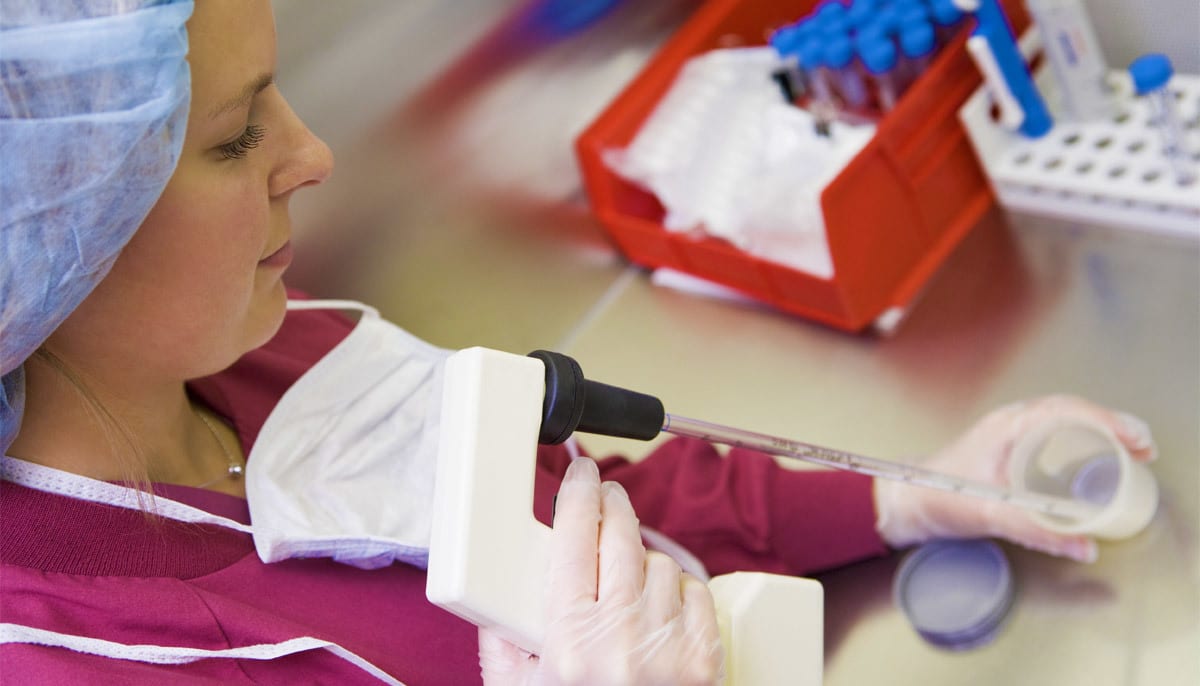June is Men’s Health Month. Reproductively speaking, healthy sperm is one indicator for men’s health. But so much goes into sperm production; such as diet, exercise, sleep, etc. So, what does SSB do with the sample after ejaculation to measure and assess sperm quality?
We often get asked about our processes, since Seattle Sperm Bank has a reputation for the industry’s highest quality vials. Therefore, we decided to sit down with our Lab Supervisor, Ryan, and answer some of the most commonly asked questions.
What exactly goes into prepping a vial?
- It’s a bit of a process, so stay with me! When receiving a sample, we immediately incubate it and put it on a shaker to liquefy and mix it. We then calculate the volume and do an initial sperm cell count. This is the first step in making sure we’re working with a high-quality sample.
- Next, we’ll gently add the sample on top of a density-gradient media which helps separate the sperm cells that we want from everything else in the ejaculate.
- We then put it through a process called centrifugation, which spins the motile sperm cells to form a “pellet” or a small ball at the bottom of the tube (healthy sperm!), and everything else gets discarded.
- We then resuspend the pellet in a “wash media” to continue purification. When you hear your clinic say you need a “washed sample”, this is the process they are referring to. The goal is to have a nice clean sample with no unwanted cellular material and a high motility percentage.
- The final step is adding a cryoprotectant to help the sperm survive the freezing and thawing process. Now we’re ready to move this sample into our liquid nitrogen tanks!
How are IUI and ICI samples different?
This is probably our most frequently asked question!
- IUI (intrauterine) donor sperm has been processed (“washed”) and is ready for insemination directly into the uterus.
- ICI (intracervical) samples are “unwashed”, so they contain all the naturally occurring seminal fluids and are safe to go directly into the cervix.
- Although these samples are prepared differently, they are used interchangeably. Clinics can use either IUI or ICI samples since they are able to wash samples as needed. IUI and ICI samples can both be used for home insemination as well.
I see you also offer ART samples. How are ART samples different from non-ART samples?
ART vials, which stands for Assisted Reproductive Technology, have fewer motile sperm cells than standard vials. Our count guarantee is 5-9 million on these samples. For certain procedures performed in a clinic, it may actually be beneficial to have fewer sperm. The most common procedure these are used for is ICSI.
My clinic says I need to get a “washed sample”. What do you do when you wash a sample and why do samples need to be washed?
An entire ejaculate is made of many types of cells and fluids. Washing a sample is done to isolate the motile sperm from the seminal fluid and other cells. This way, we get a higher concentration of good quality sperm, and naturally occurring chemicals in the sperm are removed to prevent adverse reactions within the uterus in preparation for intrauterine inseminations.
What is the difference between a total motile count and a progressive motile count?
The total motile sperm count (TOMO) is a calculation of the sample volume (think 1.0 ml) and the concentration of motile (moving!) sperm cells. At SSB, we only count sperm as being motile if they are swimming straight and at a reasonable pace, or progressive. If a sperm looks like it won’t successfully reach an egg, we’ll count it as non-motile (non-progressive).
How can you verify the sperm counts in the frozen samples?
Good question! We take a small portion of every sample into a separate vial to freeze in liquid nitrogen. The next day, we’ll thaw out these vials and do a “post-thaw” count which will tell us the quality of the vial that will one day be shipped to our clients.
How long can a sample stay viable while frozen?
Theoretically, a sample can stay viable indefinitely if it is stored correctly. Our vials are stored in liquid nitrogen at -196 degree Celsius, which effectively causes the sperm to enter a state of suspended animation.
And because we wanted to know……What do you enjoy about your work?
Working for a small company has allowed me to learn a lot and help out in other departments as needed. I can work in the lab, get to know the donors, answer questions from clients and clinics, and assist with shipping on any given day.
Got more questions about the types of vials that we offer and how SSB maintains a reputation for high-quality samples? Just ask us! cs@seattlespermbank.com or (206) 588.1484.
Ryan Bray is the Lab Supervisor for Seattle Sperm Bank and has been with SSB since 2016. Ryan oversees laboratory operations, quality control, and staff at SSB’s 3 locations in Seattle, Phoenix, and San Diego. Ryan graduated from Ferris State University with a degree in Human Biology. In his spare time, Ryan enjoys international travel, distance running, and going to breweries with his two giant dogs.


